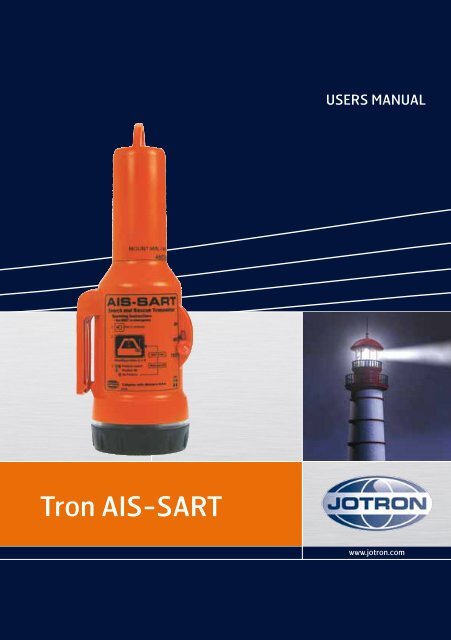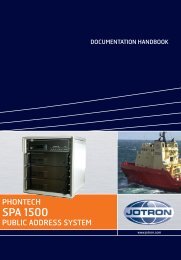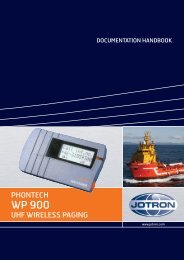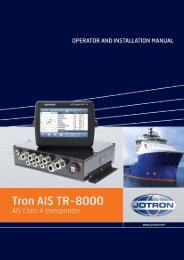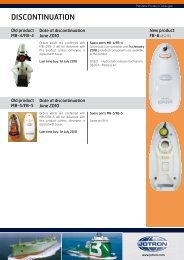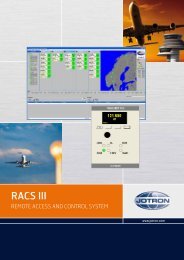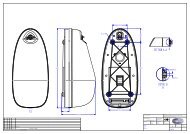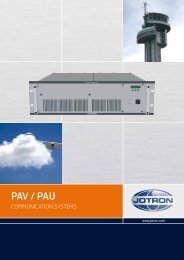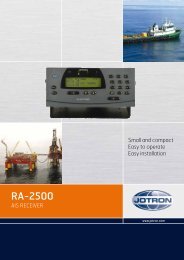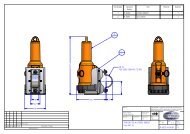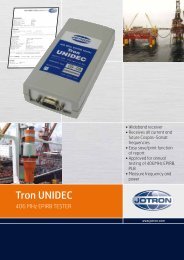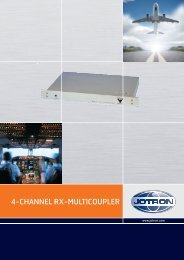Tron AIS-SART - Jotron
Tron AIS-SART - Jotron
Tron AIS-SART - Jotron
You also want an ePaper? Increase the reach of your titles
YUMPU automatically turns print PDFs into web optimized ePapers that Google loves.
USERS MANUAL<br />
<strong>Tron</strong> <strong>AIS</strong>-<strong>SART</strong><br />
www.jotron.com
www.jotron.com<br />
EC Declaration of Conformity, available at www.jotron.com<br />
The serial number is identical to the user ID of the unit.<br />
Abbreviations and definitions<br />
EMC<br />
Electromagnetic Compatibility<br />
LED<br />
Light Emitting Diode<br />
PWB<br />
Printed Wire Board<br />
RF<br />
Radio Frequency<br />
<strong>AIS</strong>-<strong>SART</strong><br />
Search and Rescue Unit based on the <strong>AIS</strong> system<br />
VHF<br />
Very High Frequency<br />
2<br />
85355_UM_<strong>AIS</strong>-<strong>SART</strong>_D
www.jotron.com<br />
Amendment Records<br />
AMEND- INCORP. DATE PAGE(S) VERSION REASON<br />
MENT NO. BY FOR CHANGE<br />
1 ES 16.06.09 Total: 28 A New product<br />
2 ES 22.11.09 Page 2 B New information<br />
3 FIT 08.12.09 Page 22-27 C Updated information<br />
4 FIT 22.03.10 Total: 30 D Updated information<br />
5<br />
6<br />
7<br />
8<br />
9<br />
10<br />
11<br />
12<br />
13<br />
14<br />
15<br />
16<br />
17<br />
85355_UM_<strong>AIS</strong>-<strong>SART</strong>_D<br />
3
www.jotron.com<br />
The information in this book has been carefully checked and is believed to<br />
be accurate. However, no responsibility is assumed for inaccuracies.<br />
CAUTION!<br />
This equipment contains CMOS integrated circuits. Observe handling precautions<br />
to avoid static discharges which may damage these devices. <strong>Jotron</strong><br />
AS reserves the right to make changes without further notice to any<br />
products or modules described herein to improve reliability, function or design.<br />
<strong>Jotron</strong> AS does not assume any liability arising out of the application<br />
or use of the described product.<br />
WARNING / IMPORTANT<br />
<strong>Jotron</strong> AS is a prime manufacturer of safety equipment designed for rescue<br />
of human lives and their property. For safety equipment to be effective in<br />
line with the design parameters it is important that they are handled, stowed<br />
and maintained in compliance with the manufacturers instructions. <strong>Jotron</strong><br />
AS cannot be held responsible for any damage caused due to incorrect use<br />
of the equipment or breach of laid down procedures or for failure of any<br />
specific component or other parts of the equipment.<br />
The chapter covering battery replacement (6.2.1) is added for information<br />
only. <strong>Jotron</strong> AS does not take any responsibility for improper disassembling/<br />
assembling of the beacon. We strongly recommend all service to be done<br />
by authorized <strong>Jotron</strong> agents. In addition to normal service, <strong>Jotron</strong> agents<br />
have the necessary equipment and knowledge to test the operational functions<br />
of the beacon. Non-original maintenance and/or service parts may<br />
destroy the equipment function and performance.<br />
4<br />
85355_UM_<strong>AIS</strong>-<strong>SART</strong>_D
www.jotron.com<br />
85355_UM_<strong>AIS</strong>-<strong>SART</strong>_D<br />
5
www.jotron.com<br />
Battery safety data sheet<br />
(Form: EEC directive 91/155)<br />
(2) SAFETY ADVICE<br />
S2 Keep out of reach of children.<br />
S8 Keep container dry.<br />
S26 In case of contact with eyes, rinse immediately with plenty of water<br />
and seek medical advice.<br />
S43 In case of fire, use D type extinguishers. Never use water.<br />
S45 In case of accident or if you feel unwell, seek medical advice immedi<br />
ately (show the label where possible).<br />
(3) FIRST AID MEASURES<br />
In case of contact of cell contents with eyes, flush immediately with water for<br />
15 min. With skin, wash with plenty of water and take off contaminated clothes.<br />
If inhaled, remove from exposure, give oxygen, and seek medical advice.<br />
(4) FIRE-FIGHTING MEASURES<br />
Extinguishing media<br />
Suitable: Type D fire extinguishers<br />
Not to be used: Water - CO2 - Halon, dry chemical or foam extinguishers<br />
Special exposure hazards<br />
Generation of chlorine, sulphur dioxide, disulphur dichloride during<br />
thermal decomposition.<br />
Special protective equipment<br />
Use protective working boots, rubber apron and safety glasses with side<br />
shields.<br />
6<br />
85355_UM_<strong>AIS</strong>-<strong>SART</strong>_D
www.jotron.com<br />
Table of contents<br />
1 General description 8<br />
1.1 <strong>Tron</strong> <strong>AIS</strong>-<strong>SART</strong> features 9<br />
1.2 Battery module 10<br />
2 Technical specifications 11<br />
2.1 Electrical specifications 11<br />
2.2 Mechanical specification 11<br />
3 Functional description 12<br />
3.1 General 12<br />
3.1.1 <strong>Tron</strong> <strong>AIS</strong>-<strong>SART</strong> electronic assembly 12<br />
3.1.2 Battery module 13<br />
3.1.3 Bottom lid 13<br />
4 Installation 14<br />
4.1 Brackets 14<br />
4.1.1 Wall bracket 14<br />
4.1.2 Lifeboat bracket 15<br />
4.2 Installation tips 17<br />
4.2.1 How to use the brackets in life rafts 17<br />
4.2.2 Installation diagram 18<br />
4.2.3 Mounting a pipe 18<br />
4.3 Using the telescopic pole 20<br />
4.4 Using the 10m rope 21<br />
5 Operating instructions 22<br />
5.1 Test of <strong>Tron</strong> <strong>AIS</strong>-<strong>SART</strong> 22<br />
5.2 Activating <strong>Tron</strong> <strong>AIS</strong>-<strong>SART</strong> 23<br />
5.2.1 Reception on a non <strong>AIS</strong>-<strong>SART</strong> compliant<br />
<strong>AIS</strong> transponder 23<br />
5.2.2 Reception on a non <strong>AIS</strong>-<strong>SART</strong> compliant<br />
electronic chart (ECS/ECDIS) 23<br />
5.2.3 Reception on an <strong>AIS</strong>-<strong>SART</strong> compliant<br />
<strong>AIS</strong> transponder 24<br />
5.2.2 Reception on an <strong>AIS</strong>-<strong>SART</strong> compliant<br />
electronic chart (ECS/ECDIS) 24<br />
6 Maintenance and troubleshooting 25<br />
6.1 Maintenance 25<br />
6.2 Service 25<br />
6.2.1 Replacing the battery module 26<br />
6.2.2 Battery disposal 28<br />
6.2.3 Incineration 28<br />
6.2.4 Land filling 28<br />
6.2.5 Recycling 28<br />
7 Service agents 29<br />
85355_UM_<strong>AIS</strong>-<strong>SART</strong>_D<br />
7
www.jotron.com<br />
1 GENERAL DESCRIPTION<br />
<strong>Tron</strong> <strong>AIS</strong>-<strong>SART</strong> is a battery powered <strong>AIS</strong> emergency transmitter in a sealed waterproof<br />
enclosure consisting of:<br />
1. <strong>Tron</strong> <strong>AIS</strong>-<strong>SART</strong> unit<br />
2. Mounting rope for life rafts / life boats.<br />
The <strong>Tron</strong> <strong>AIS</strong>-<strong>SART</strong> is developed by <strong>Jotron</strong> AS to meet the rules and regulations<br />
for use on vessels and life rafts in the maritime service.<br />
<strong>Tron</strong> <strong>AIS</strong>-<strong>SART</strong> meets the specifications for use in search and rescue operations<br />
at sea.<br />
The operating range of the <strong>Tron</strong> <strong>AIS</strong>-<strong>SART</strong> is 7 -10 nautical miles from vessel<br />
<strong>AIS</strong> Class-A, and more than 40 nautical miles from an airborne <strong>AIS</strong> receiver.<br />
<strong>Tron</strong> <strong>AIS</strong>-<strong>SART</strong> is buoyant, however to obtain maximum performance, the unit<br />
should be placed in a vertical position and as high up as possible in order to<br />
achieve maximum coverage.<br />
Several mounting brackets and mounting aids are available to ensure correct<br />
mounting and use of the radar unit.<br />
The purpose of the <strong>Tron</strong> <strong>AIS</strong>-<strong>SART</strong> is to perform a secondary alarm when search<br />
and rescue units are searching for a life raft / lifeboat in distress. The <strong>Tron</strong><br />
<strong>AIS</strong>-<strong>SART</strong> includes a built-in GPS, which will help the units to pinpoint exactly<br />
where the distressed boat is located in a larger area. This is done with the help<br />
of the <strong>AIS</strong> on the searching ship or helicopter. When started, the <strong>Tron</strong> <strong>AIS</strong>-<strong>SART</strong><br />
sends its position data in an ordinary <strong>AIS</strong> message.<br />
In addition the <strong>Tron</strong> <strong>AIS</strong>-<strong>SART</strong> sends a safety text message every forth minute,<br />
containing text: “<strong>AIS</strong> <strong>SART</strong>”. This will be received by other <strong>AIS</strong> systems within<br />
the range.<br />
The batteries of the <strong>Tron</strong> <strong>AIS</strong>-<strong>SART</strong> will last at least 96 hours when activated<br />
and then minimum 8 hours of continuous operation.<br />
8<br />
85355_UM_<strong>AIS</strong>-<strong>SART</strong>_D
www.jotron.com<br />
To save battery capacity in case of a situation where the unit is needed, the use<br />
should be limited to tests and emergency situations.<br />
1.1 <strong>Tron</strong> <strong>AIS</strong>-<strong>SART</strong> features<br />
Watertight:<br />
<strong>Tron</strong> <strong>AIS</strong>-<strong>SART</strong> is watertight to a depth of minimum 1 meter.<br />
Buoyant:<br />
<strong>Tron</strong> <strong>AIS</strong>-<strong>SART</strong> is buoyant in case the unit is accidentally dropped into the water.<br />
To increase coverage the <strong>AIS</strong>-<strong>SART</strong> should always be held or mounted as<br />
high as possible.<br />
Rugged design:<br />
The <strong>Tron</strong> <strong>AIS</strong>-<strong>SART</strong> will withstand a drop from 20 meters into the water. It is<br />
resistant to seawater, oil and sunlight.<br />
Handling:<br />
<strong>Tron</strong> <strong>AIS</strong>-<strong>SART</strong> is designed for easy operation, with a brief operating instruction<br />
printed on the unit. It comes standard with a 10 meter rope and a shackle hook<br />
to be used for hanging the <strong>AIS</strong>-<strong>SART</strong> on the inside of a life raft.<br />
Indicators:<br />
<strong>Tron</strong> <strong>AIS</strong>-<strong>SART</strong> is equipped with two colored LEDs, one green and one red. The<br />
LEDs will give visual status of operation and faults. In addition a built in buzzer<br />
beeps regularly to indicate operation.<br />
FUNCTION INDICATOR BUZZER<br />
GPS position fix OK Green LED flashes Regularly beep<br />
Searching for Red and Green Regularly beep<br />
GPS fix<br />
LED flashes<br />
No GPS fix, count Red LED flashes Regularly beep<br />
number of flashes.<br />
See table 1.1.b<br />
Table 1 Functions<br />
85355_UM_<strong>AIS</strong>-<strong>SART</strong>_D<br />
9
www.jotron.com<br />
1.2 Battery module<br />
The Battery Module comprises of two C-size Lithium batteries, a battery housing, a connector and<br />
cables. The battery module is to be replaced every 5th year. A battery expiry label on the <strong>Tron</strong> <strong>AIS</strong>-<br />
<strong>SART</strong> housing displays the expiry date.<br />
A new battery comes complete with cable and connector.<br />
10<br />
85355_UM_<strong>AIS</strong>-<strong>SART</strong>_D
www.jotron.com<br />
2 TECHNICAL SPECIFICATIONS<br />
2.1 ELECTRICAL SPECIFICATIONS<br />
Frequency:<br />
161.975MHz and 162.025MHz<br />
Temperature range: Operating: -20°C to +55°C<br />
Storage:<br />
-30°C to +70°C<br />
Radiated power (e.i.r.p): 1W (30dBm ± 3dB)<br />
Antenna pattern: Vertical polarization<br />
Battery:<br />
Two C-size SAFT LSH 14 light Lithium batteries,<br />
5 years service life.<br />
Battery capacity: 96 hours operation when activated at -20°C<br />
5 years storage<br />
2.2 MECHANICAL SPECIFICATION<br />
Materials used:<br />
Unit housing:<br />
Bracket:<br />
Unit dimensions:<br />
Max diameter:<br />
Length:<br />
Weight:<br />
Polycarbonate with 10% fiberglass<br />
PLAST+<br />
Anodized aluminum<br />
89 mm<br />
251 mm<br />
450g<br />
Unit with standard storage bracket:<br />
Max diameter:<br />
90 mm<br />
Length:<br />
251 mm<br />
85355_UM_<strong>AIS</strong>-<strong>SART</strong>_D<br />
11
www.jotron.com<br />
3 FUNCTIONAL DESCRIPTION<br />
3.1 GENERAL<br />
<strong>Tron</strong> <strong>AIS</strong>-<strong>SART</strong> consists of a housing sealed at the lower end with a bottom lid<br />
and may be split into the following main parts:<br />
1. Bottom lid.<br />
2. Housing with <strong>Tron</strong> <strong>AIS</strong>-<strong>SART</strong> electronic assembly and battery module.<br />
The housing is made of polycarbonate.<br />
3. Base of antenna<br />
1 2<br />
3<br />
Figure 3.1, <strong>Tron</strong> <strong>AIS</strong>-<strong>SART</strong> disassembled<br />
3.1.1 TRANSMITTER MODULE<br />
<strong>Tron</strong> <strong>AIS</strong>-<strong>SART</strong> transmitter module is inserted into the <strong>Tron</strong> <strong>AIS</strong>-<strong>SART</strong> housing.<br />
It consists of the main board, antenna and two screen boxes which is mounted<br />
in the housing. It can be divided into the following sections:<br />
1. Transmitter module<br />
2. Antenna<br />
3. Screen Boxes<br />
4. Base of antenna<br />
1 4 2<br />
3<br />
Figure 3.1.1 <strong>Tron</strong> <strong>AIS</strong>-<strong>SART</strong> Transmitter module<br />
12<br />
85355_UM_<strong>AIS</strong>-<strong>SART</strong>_D
www.jotron.com<br />
3.1.2 BATTERY MODULE (see page 26 for decription of battery change)<br />
The battery module is inserted into the <strong>Tron</strong> <strong>AIS</strong>-<strong>SART</strong> housing.<br />
A battery expiry label on the <strong>Tron</strong> <strong>AIS</strong>-<strong>SART</strong> housing displays the battery expiry<br />
date.<br />
A new battery module comes complete with cable and connector and can be<br />
changed by opening the bottom lid at of the <strong>Tron</strong> <strong>AIS</strong>-<strong>SART</strong>.<br />
Figure 3.1.2 TRON <strong>AIS</strong>-<strong>SART</strong> BATTERY<br />
- module without cable and connector<br />
3.1.3 BOTTOM LID<br />
The Bottom lid includes four items:<br />
Battery expiry<br />
label<br />
1. The winder hook<br />
2. The screw ring<br />
3. The light tower<br />
4. The O-ring<br />
2<br />
1<br />
3<br />
4<br />
Figure 3.1.3 Bottom lid<br />
85355_UM_<strong>AIS</strong>-<strong>SART</strong>_D<br />
13
www.jotron.com<br />
4 INSTALLATION<br />
<strong>Tron</strong> <strong>AIS</strong>-<strong>SART</strong> can be mounted several ways, depending on the options available.<br />
As a general rule, the transponder should be mounted as high as possible<br />
to increase line of sight to the search and rescue units.<br />
Metal objects close to the transponder should be avoided, these will limit the<br />
performance in the directions they are located.<br />
4.1 BRACKETS<br />
There are two different mounting brackets available.<br />
1. Wall bracket<br />
2. Lifeboat bracket<br />
3. Pole bracket<br />
4.1.1 WALL BRACKET<br />
A wall bracket is delivered with the <strong>Tron</strong> <strong>AIS</strong>-<strong>SART</strong> and should be used for storage<br />
of the unit. The bracket should preferably be mounted in a vertical position<br />
and in a place where the <strong>Tron</strong> <strong>AIS</strong>-<strong>SART</strong> is easily available in case of an<br />
emergency.<br />
Figure 4.1.1a, wall bracket.<br />
Figure 4.1.1b, <strong>Tron</strong> <strong>AIS</strong>-<strong>SART</strong><br />
mounted in wall bracket.<br />
The bracket should be mounted with four screws (Ø 4 mm).<br />
14<br />
85355_UM_<strong>AIS</strong>-<strong>SART</strong>_D
www.jotron.com<br />
4.1.2 LIFEBOAT BRACKET<br />
The outdoor lifeboat bracket should be mounted vertically on the roof of the<br />
lifeboat (as high as possible).<br />
Activate the unit and put it into the bracket. Secure the transponder to the<br />
bracket. The bracket will fit a pipe with a maximum diameter of 50mm.<br />
Figure 4.1.2a, Lifeboat bracket.<br />
Item Document Title<br />
nr. nr.<br />
1 M-82746 WALL BRACKET<br />
2 M-84163_WELDAMENT M-84163_BRACKET_UNIVERSAL_<br />
WELDAMENT D 1<br />
3 M-80312 Nut nylock M4 DIN 985<br />
4 M-84676 Screw, DIN965 - Pozidrive M4x12<br />
5 M-84854 Screw, DIN965 - Pozidrive M6x70<br />
6 M-84855 Screw, DIN965 - Pozidrive M6x90<br />
7 M-84838 PIPE CLAMP<br />
13 M-84875 WASHER PLATE<br />
14 M-91469 Nut nylock M6 DIN 985<br />
15 M-82275 WASHER, DIN9021 Ø6mm<br />
85355_UM_<strong>AIS</strong>-<strong>SART</strong>_D<br />
15
www.jotron.com<br />
Figure 4.1.2b, <strong>Tron</strong> <strong>AIS</strong>-<strong>SART</strong> lifeboat bracket.<br />
Figure 4.1.2c, <strong>AIS</strong>-<strong>SART</strong> to<br />
put into lifeboat bracket.<br />
Figure 4.1.2d Example of Mounting the Bracket on<br />
Interior and Exterior Walls of a Lifeboat<br />
16<br />
85355_UM_<strong>AIS</strong>-<strong>SART</strong>_D
www.jotron.com<br />
4.2 INSTALLATION TIPS<br />
4.2.1 How to use the bracket in life rafts<br />
Tent air tube<br />
Entrance/Exit<br />
<strong>AIS</strong>-<strong>SART</strong> main unit<br />
Hang the <strong>AIS</strong>-<strong>SART</strong> from the <strong>AIS</strong>-<strong>SART</strong><br />
installation seat or radar reflector<br />
<strong>AIS</strong>-<strong>SART</strong> main unit<br />
Pole<br />
Figure 4.2.1, How to mount <strong>Tron</strong> <strong>AIS</strong>-<strong>SART</strong> to a liferaft<br />
85355_UM_<strong>AIS</strong>-<strong>SART</strong>_D<br />
17
www.jotron.com<br />
4.2.2 Installation diagram<br />
<strong>Tron</strong> <strong>AIS</strong>-<strong>SART</strong> main unit<br />
The base of antenna<br />
The state when inserted<br />
into the wall bracket<br />
Clip<br />
Insert the clip of the <strong>AIS</strong>-<br />
<strong>SART</strong> main unit into the<br />
wall bracket from a top<br />
Wall<br />
Wall bracket:<br />
- For mounting, use 3 mm<br />
screws or wood screws,<br />
depending on the wall type<br />
Figure 4.2.2, Installation diagram of the <strong>AIS</strong>-<strong>SART</strong> main unit and the wall bracket<br />
4.2.3 Mounting to a pipe<br />
Figure 4.2.3a, Examples of pipe mounting<br />
18<br />
85355_UM_<strong>AIS</strong>-<strong>SART</strong>_D
www.jotron.com<br />
Figure 4.2.3b, Mounting to a pipe, example of reference<br />
85355_UM_<strong>AIS</strong>-<strong>SART</strong>_D<br />
19
www.jotron.com<br />
4.3 USING THE TELESCOPIC POLE<br />
Figure 4.3, <strong>Tron</strong> <strong>AIS</strong>-<strong>SART</strong> with telescopic pole attached.<br />
A telescopic pole can be used to extend the height of the <strong>Tron</strong> <strong>AIS</strong>-<strong>SART</strong>, inside<br />
or outside the life raft/boat. Simply extend the attached pole to the full length<br />
(app. 1,2m from the top of the <strong>Tron</strong> <strong>AIS</strong>-<strong>SART</strong>). Make sure that the rod is locked<br />
by pulling hard when it is fully extended. The rod can now be fastened or held<br />
by a person. Ensure the rod is held as vertical as possible when activating the<br />
<strong>Tron</strong> <strong>AIS</strong>-<strong>SART</strong>.<br />
20<br />
85355_UM_<strong>AIS</strong>-<strong>SART</strong>_D
www.jotron.com<br />
4.4 USING THE 10M ROPE<br />
The 10m. rope is meant to hang the <strong>Tron</strong> <strong>AIS</strong>-<strong>SART</strong> inside a life raft. Any objects<br />
that the rope can be attached to can be used. As long as the <strong>AIS</strong>-<strong>SART</strong> is kept<br />
away from any metal objects, the performance will not be notable degraded<br />
because of the canvas of the life raft.<br />
Figure 4.4, <strong>Tron</strong> <strong>AIS</strong>-<strong>SART</strong> with 10m rope attached.<br />
85355_UM_<strong>AIS</strong>-<strong>SART</strong>_D<br />
21
www.jotron.com<br />
5 OPERATING INSTRUCTIONS<br />
5.1 TEST OF TRON <strong>AIS</strong>-<strong>SART</strong><br />
1. Test must be conducted outdoors with a clear view to the sky to maximize<br />
GPS location.<br />
2. Move the switch to “TEST” position<br />
until the LEDs start flashing.<br />
<strong>Tron</strong> <strong>AIS</strong>-<strong>SART</strong> will now run through a self<br />
test procedure. If a Red LED flashes, it<br />
is indication of critical faults. *See table<br />
below for error codes.<br />
3. Release the switch when both LEDs start flashing.<br />
The unit will now search for GPS position for maximum<br />
15 minutes.<br />
4. A successful test is indicated by 15 second beep<br />
and Green LED . See next page for description of indication<br />
on a <strong>AIS</strong> transponder/ Electronic chart etc<br />
5. An unsuccessful test is indicated by 15 second<br />
beep and Red LED. Please relocate the unit and<br />
restart test.<br />
6. To cancel ongoing test, hold the switch on the<br />
<strong>Tron</strong> <strong>AIS</strong>-<strong>SART</strong> in the “TEST” position until the buzzer<br />
starts to beep.<br />
*Error codes if<br />
RED flash in“2.”<br />
Number of red LED flash Fault indication<br />
2 Transmit power failure<br />
3 Low battery<br />
4 Transmit frequency error<br />
5 User ID not programmed<br />
6 Undefined, contact <strong>Jotron</strong><br />
7 Internal communication error<br />
22<br />
85355_UM_<strong>AIS</strong>-<strong>SART</strong>_D
www.jotron.com<br />
5.2 ACTIVATING TRON <strong>AIS</strong>-<strong>SART</strong><br />
Today, most <strong>AIS</strong> transponders installed are not compliant with <strong>AIS</strong>-<strong>SART</strong>, but<br />
will still receive them as another ship, both with ID code, Position, Range, Bearing,<br />
and Text message<br />
5.2.1 RECEPTION ON A NON <strong>AIS</strong>-<strong>SART</strong> COMPLIANT <strong>AIS</strong> TRANSPONDER:<br />
- will be shown as a ship without name, with MMSI (here<br />
“ID code”), range, bearing and position:<br />
- Some <strong>AIS</strong> transponders will show MMSI (here “ID code”) when no<br />
vessel name is received<br />
- In addition, a text message will be received:<br />
5.2.2 RECEPTION AN A NON <strong>AIS</strong>-<strong>SART</strong> COMPLIANT ELECTRONIC<br />
CHART (ECS/ECDIS):<br />
- will be shown as a ship<br />
- with the same text message received: <strong>SART</strong> ACTIVE<br />
85355_UM_<strong>AIS</strong>-<strong>SART</strong>_D<br />
23
www.jotron.com<br />
5.2.3. RECEPTION ON AN <strong>AIS</strong>-<strong>SART</strong> COMPLIANT <strong>AIS</strong> TRANSPONDER:<br />
The requirement to have a <strong>AIS</strong>-<strong>SART</strong> compliant <strong>AIS</strong> transponder, is not ready<br />
yet, not when it will be implemented, nor what the final requirement will be. But<br />
there are drafts of new <strong>AIS</strong> specification, IEC 61993-2 (Ed.2) which states:<br />
By default the target list is auto-sorted in ascending range except the<br />
nearest active <strong>AIS</strong> <strong>SART</strong> or, if supported, other target of interest shall be<br />
displayed at the top of the list.<br />
• will be possibly be shown with the text “<strong>SART</strong> ACTIVE” as “vessel name”<br />
with range, bearing and position:<br />
• In addition, a text message will be received:<br />
5.2.4. RECEPTION ON AN <strong>AIS</strong>-<strong>SART</strong> COMPLIANT ELECTRONIC CHART<br />
(ECS/ECDIS):<br />
Even though the <strong>AIS</strong> transponder is not <strong>AIS</strong>-<strong>SART</strong> compliant, the electronic<br />
chart may show the correct symbol when receiving an <strong>AIS</strong>-<strong>SART</strong> in “Test” or<br />
“Active” if it is updated to the latest revisions defined below:<br />
- will be shown with this special symbol (red) as defined here:<br />
SN.1/Circ.243/Add.1 and in lates revision of IEC 62388:<br />
- An <strong>AIS</strong> search and rescue transmitter (<strong>SART</strong>) shall be drawn with<br />
a solid line and shall have the same basic colour as the <strong>AIS</strong> ATON<br />
symbols.<br />
- with the same text message received: <strong>SART</strong> ACTIVE<br />
24<br />
85355_UM_<strong>AIS</strong>-<strong>SART</strong>_D
www.jotron.com<br />
6 MAINTENANCE AND TROUBLESHOOTING<br />
6.1 MAINTENANCE<br />
<strong>Tron</strong> <strong>AIS</strong>-<strong>SART</strong> requires the following maintenance:<br />
Every 6. month.<br />
The unit should be taken out of its bracket and tested using the procedure in<br />
chapter 5.1.<br />
Every 5. year.<br />
The battery unit must be replaced every 5 year. Storage of batteries over a long<br />
period of time will reduce their capacity. To ensure long and reliable operation<br />
the battery unit must be replaced every 5 year. The battery replacement can be<br />
performed on board using the procedure in chapter 6.2.1.<br />
6.2 SERVICE<br />
Warranty Service<br />
The warranty of the equipment is void if the customer has tried to repair, modify<br />
or rebuild the unit, deliberate or accidental damage, failure to follow <strong>Jotron</strong><br />
instructions with respect to approved service agents or if the unit has been exposed<br />
to environmental conditions outside the specifications of the unit. As<br />
standard <strong>Jotron</strong> AS warrants that this product will be free from defects in materials<br />
and workmanship for a period of 12 months from the date received by end<br />
user, limited to 18 months from purchase from <strong>Jotron</strong> AS.<br />
If the unit is in need of repair, please return it carriage paid to the agent that you<br />
purchased it from. Provided that the unit(s) returned for repair is found to be<br />
under warranty, man-hour cost and material cost will be covered by <strong>Jotron</strong> AS.<br />
Additional costs not related to repair/replacement of the unit will not be covered.<br />
Out of Warranty Service<br />
For defects arising from normal wear and tear after 12 months of operation,<br />
limited to 18 months from <strong>Jotron</strong> AS, normal service conditions will apply. For<br />
details see: www.jotron.com<br />
85355_UM_<strong>AIS</strong>-<strong>SART</strong>_D<br />
25
www.jotron.com<br />
6.2.1 REPLACING THE BATTERY MODULE<br />
Below is a description on how to change batteries on <strong>AIS</strong>-<strong>SART</strong><br />
Dissasembly:<br />
Twist the rubber grip<br />
anti-clockwise to<br />
remove the lid<br />
It might be difficult<br />
to remove the lid. If<br />
so, remove the rubber<br />
grip first<br />
And then twist off<br />
the lid<br />
Opened<br />
Rubber holder below<br />
battery and electronics<br />
removed<br />
Pull out the battery<br />
Pull out the cable from connector<br />
Remove old Silaca<br />
gel bags<br />
26<br />
85355_UM_<strong>AIS</strong>-<strong>SART</strong>_D
www.jotron.com<br />
Assembly:<br />
Install the new battery.<br />
Make sure the<br />
cable is within the<br />
guide<br />
Connect cable to<br />
electronics,<br />
black= left,<br />
red= right<br />
Add 2x5 g Silica<br />
gel bags<br />
Mount rubber<br />
holder<br />
Remove old O-ring<br />
using a Credit Card<br />
Use acid-free<br />
Vaseline on the<br />
new O-ring<br />
Fit the new<br />
O-ring<br />
Reinstall lid- tighten<br />
without tools<br />
Replace the rubber<br />
grip<br />
Assembly completed<br />
85355_UM_<strong>AIS</strong>-<strong>SART</strong>_D<br />
27
www.jotron.com<br />
6.2.2 BATTERY DISPOSAL<br />
Dispose in accordance with applicable regulations, which vary from country<br />
to country.(In most countries, the disposal of used batteries is regulated and<br />
end-users are invited to dispose of them correctly, through non-profit organizations,<br />
mandated by local governments or organized on a voluntary basis by<br />
professionals). Lithium batteries should have their terminals insulated prior to<br />
disposal.<br />
6.2.3 INCINERATION<br />
Incineration should never be performed by battery users but by trained professionals<br />
in authorized facilities with proper gas and fumes treatment.<br />
6.2.4 LAND FILLING<br />
Leachability regulations (mg/l)<br />
Component Leachability EC limit EPA Other*<br />
Iron 100 5<br />
Nickel 100 500 2 0,5<br />
* Applicable to France<br />
6.2.5 RECYCLING<br />
Send to authorized recycling facilities, through a licensed waste carrier.<br />
28<br />
85355_UM_<strong>AIS</strong>-<strong>SART</strong>_D
www.jotron.com<br />
7 SERVICE AGENTS<br />
Please look at www.jotron.com for Marine Service Agents.<br />
<strong>Jotron</strong> Group subsidiary companies:<br />
<strong>Jotron</strong> UK Ltd.<br />
Crosland Park, Off Crowhall Road<br />
Cramlington<br />
Northumberland NE23 1LA<br />
United Kingdom<br />
Tel +44 1670 712000<br />
Fax +44 1670 590265<br />
E-mail: sales@jotron.co.uk<br />
<strong>Jotron</strong> Asia Pte. Ltd.<br />
Changi Logistics Center<br />
19 Loyang Way #04-26<br />
Singapore 508724<br />
Tel +65 65426350<br />
Fax +65 65429415<br />
E-mail: sales@jotron-asia.com<br />
<strong>Jotron</strong> USA, Inc.<br />
10645 Richmond Avenue, Suite 140<br />
Houston, TX 77042<br />
USA<br />
Tel +1 713 268 1061<br />
Fax +1 713 268 1062<br />
E-mail: contact.us@jotron-usa.com<br />
85355_UM_<strong>AIS</strong>-<strong>SART</strong>_D
www.jotron.com


